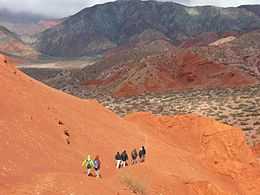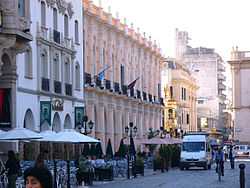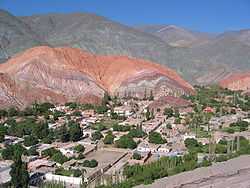Argentine Northwest
The Argentine Northwest (Noroeste Argentino) is a geographic and historical region of Argentina composed of the provinces of Catamarca, Jujuy, La Rioja, Salta, Santiago del Estero and Tucumán.
Geography
The Argentine Northwest comprises very distinct biomes, or geographical and climatic regions. From west to east they are:
- The Altiplano or "Puna"
- High Mountains of the Andes
- Fertile valleys
- Red-rock canyons and mountain passes
- Humid Sub-Andean Sierras
- Tropical jungles or Yungas
- And the ecotone—or transitional zone—between the Yungas and the Chaco region.
Besides the Yungas jungle on the eastern fringe of the region, the only fertile lands are those near the river basins, which have been irrigated extensively. Across millennia the erosive forces of these rivers has gradually created a multitude of red-rock canyons, such as the Quebrada de Humahuaca and the Valles Calchaquíes.
West of these valleys the peaks of the Andes reach heights of over 6,000 metres (20,000 ft) and the Altiplano, an extensive 3,500-meter high plateau, dominates the landscape and continues far north into Bolivia and Southern Peru.
Weather
As moist easterly winds reach the sub-Andean Sierras and the eastern slopes of the Andes, they drop much of their moisture. As a result, these areas—such as the Yungas jungle mentioned above—are characterized by a warm sub-tropical climate with abundant rain.
The now dry winds then continue their path to the west, leaving the Puna and the arid Steppe with wide temperature differences. This latter climate pattern is common in much of the region.
Precipitation in the Argentine northwest follows a summer monsoon pattern, with most of the 700 millimetres (28 in) of annual rainfall falling in the austral summer from December to March.[1]
Economy
The majority of the population—and thus economic activity—of this region is concentrated in the many fertile valleys. In these valleys, the cultivation of sugarcane, tobacco, and citrus is the most important activity, along with cattle and goat raising. Important vineyards are also found in the Valles Calchaquíes in the Cafayate region.
Thus most economic activity is associated with agriculture, with the exception of the "Altos Hornos Zapala" steel furnace.
Mining includes lead, silver, zinc and salt, and hydrocarbons extraction.
| Regions of Argentina |
|---|
Tourism

The Argentine Northwest is a popular destination for both domestic and international travelers, attracting neighboring Argentinos and vacationing Europeans alike. Some of the most popular destination are Quebrada de Humahuaca and the Cerro de los Siete Colores, Cafayate and the Valles Calchaquíes, Tafí del Valle, and the capital cities of the provinces: San Miguel de Tucumán, San Fernando del Valle de Catamarca, Salta and San Salvador de Jujuy.
The national parks of the region are: Baritú National Park, Calilegua National Park, El Rey National Park, Los Cardones National Park and Campo de los Alisos National Park.
Cultural tourism
Besides the geography of the area, the culture is also of great interest. It is strongly influenced by Quechua and Aymara cultures, and the region is quite distinct from the more European Buenos Aires.
This influence can be seen in the music, clothing and customs of the people.
See also
References
External links
- The Andean northwest
- Argentine Northwest (Spanish)
- Map with routes
- Monografias.com:Argentine Northwest (Spanish)
- Argentine Northwest art (Spanish)

